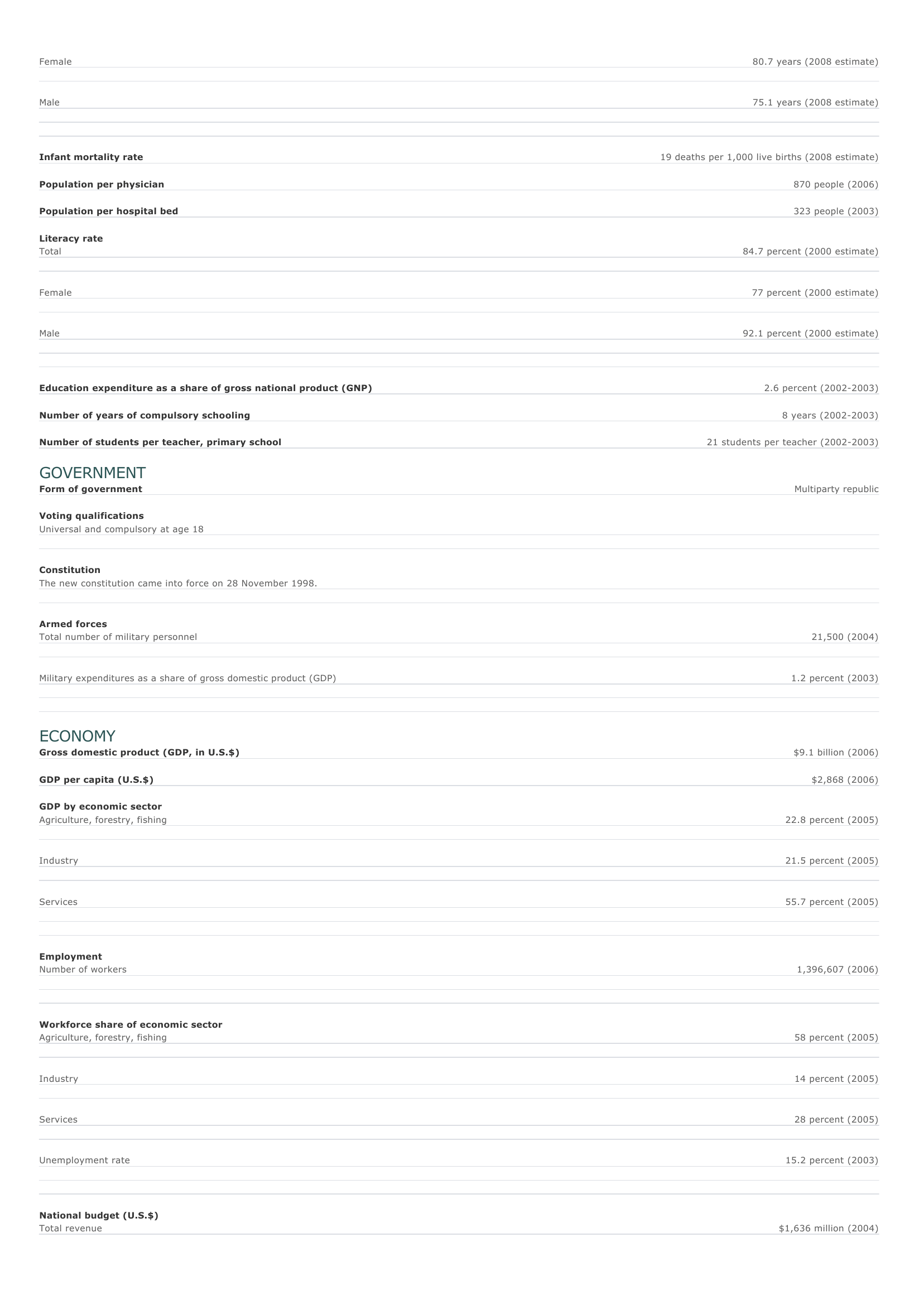Albania Facts and Figures. BASIC FACTS Official name Capital Area Republic of Albania Tirana 28,748 sq km 11,100 sq mi PEOPLE Population 3,619,778 (2008 estimate) Population growth Population growth rate 0.54 percent (2008 estimate) Projected population in 2025 3,944,360 (2025 estimate) Projected population in 2050 4,016,945 (2050 estimate) Population density 132 persons per sq km (2008 estimate) 342 persons per sq mi (2008 estimate) Urban/rural distribution Share urban 45 percent (2005 estimate) Share rural 55 percent (2005 estimate) Largest cities, with population Tirana 367,000 (2003 estimate) D urrës 99,546 (2001 estimate) Elbasan 87,797 (2001 estimate) S hkodër 82,445 (2001 estimate) Vlorë 77,691 (2001 estimate) Ethnic groups Albanian 95 percent G reek 3 percent Other (Vlachs, Roma [Gypsies], Serbs, and Bulgarians) 2 percent Languages Albanian (Tosk is the official dialect; Gheg is spoken primarily in the north), Greek Religious affiliations Muslim 70 percent Orthodox Christian 20 percent Roman Catholic 10 percent HEALTH AND EDUCATION Life expectancy Total 77.8 years (2008 estimate) Female 80.7 years (2008 estimate) Male 75.1 years (2008 estimate) Infant mortality rate 19 deaths per 1,000 live births (2008 estimate) Population per physician 870 people (2006) Population per hospital bed 323 people (2003) Literacy rate Total Female Male Education expenditure as a share of gross national product (GNP) Number of years of compulsory schooling Number of students per teacher, primary school 84.7 percent (2000 estimate) 77 percent (2000 estimate) 92.1 percent (2000 estimate) 2.6 percent (2002-2003) 8 years (2002-2003) 21 students per teacher (2002-2003) GOVERNMENT Form of government Multiparty republic Voting qualifications Universal and compulsory at age 18 Constitution The new constitution came into force on 28 November 1998. Armed forces Total number of military personnel Military expenditures as a share of gross domestic product (GDP) 21,500 (2004) 1.2 percent (2003) ECONOMY Gross domestic product (GDP, in U.S.$) GDP per capita (U.S.$) $9.1 billion (2006) $2,868 (2006) GDP by economic sector Agriculture, forestry, fishing 22.8 percent (2005) I ndustry 21.5 percent (2005) Services 55.7 percent (2005) Employment Number of workers 1,396,607 (2006) Workforce share of economic sector Agriculture, forestry, fishing 58 percent (2005) I ndustry 14 percent (2005) Services 28 percent (2005) Unemployment rate 15.2 percent (2003) National budget (U.S.$) Total revenue $1,636 million (2004) Total expenditure Monetary unit $1,762 million (2004) 1 lek (L), consisting of 100 quindarka Major trade partners for exports Italy, Greece, Germany, Serbia, United States Major trade partners for imports Italy, Greece, Turkey, Germany, United Kingdom ENERGY, COMMUNICATIONS, AND TRANSPORTATION Electricity production Electricity from thermal sources Electricity from hydroelectric sources 4.77 percent (2003 estimate) 95.23 percent (2003 estimate) Electricity from nuclear sources 0 percent (2003 estimate) Electricity from geothermal, solar, and wind sources 0 percent (2003 estimate) Number of radios per 1,000 people 259 (1997) Number of telephones per 1,000 people 88 (2004) Number of televisions per 1,000 people 141 (2000 estimate) Number of Internet hosts per 10,000 people 0.81 (2003) Daily newspaper circulation per 1,000 people 34 (1996) Number of motor vehicles per 1,000 people 70 (2002) Paved road as a share of total roads 39 percent (2002) SOURCES Basic Facts and People sections Area data are from the statistical bureaus of individual countries. Population, population growth rate, and population projections are from the United States Census Bureau, International Programs Center, International Data Base (IDB) (www.census.gov). Urban and rural population data are from the Food and Agriculture Organization (FAO) of the United Nations (UN), FAOSTAT database (www.fao.org). Largest cities population data and political divisions data are from the statistical bureaus of individual countries. Ethnic divisions and religion data are largely from the latest Central Intelligence Agency (CIA) World Factbook and from various country censuses and reports. Language data are largely from the Ethnologue, Languages of the World, Summer Institute of Linguistics International (www.sil.org). Health and Education section Life expectancy and infant mortality data are from the United States Census Bureau, International Programs Center, International database (IDB) (www.census.gov). Population per physician and population per hospital bed data are from the World Health Organization (WHO) (www.who.int). Education data are from the United Nations Educational, Scientific and Cultural Organization (UNESCO) database (www.unesco.org). Government section Government, independence, legislature, constitution, highest court, and voting qualifications data are largely from various government Web sites, the latest Europa World Yearbook, and the latest Central Intelligence Agency (CIA) World Factbook. The armed forces data is from Military Balance. Economy section Gross domestic product (GDP), GDP per capita, GDP by economic sectors, employment, and national budget data are from the World Bank database (www.worldbank.org). Monetary unit, agriculture, mining, manufacturing, exports, imports, and major trade partner information is from the statistical bureaus of individual countries, latest Europa World Yearbook, and various United Nations and International Monetary Fund (IMF) publications. Energy, Communication, and Transportation section Electricity information is from the Energy Information Administration (EIA) database (www.eia.doe.gov). Radio, telephone, television, and newspaper information is from the United Nations Educational, Scientific and Cultural Organization (UNESCO) database (www.unesco.org). Internet hosts, motor vehicles, and road data are from the World Bank database (www.worldbank.org). Note Figures may not total 100 percent due to rounding. Microsoft ® Encarta ® 2009. © 1993-2008 Microsoft Corporation. All rights reserved.











